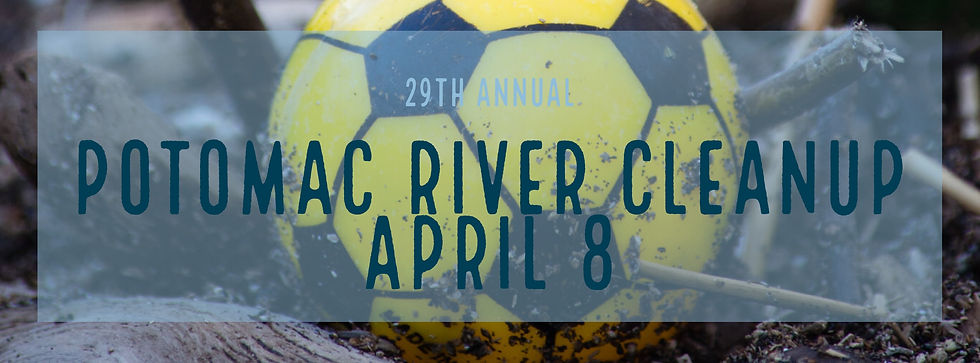Potomac River Shoreline Cleanup Resources
- Accokeek Foundation

- Mar 23, 2021
- 4 min read
Calling all Trash Avengers, Pollution Picker-uppers, Shoreline Savers, and Cleanup Contractors! As the weather warms and spring rains descend, the Potomac River shoreline will increase in biodiversity and activity as all of the hibernators wake up and migrators return. However, that activity also includes an increase in man-made biohazards and waste washing onto the banks as the Potomac carries it towards the Bay.

While this sight alone is grieving to the eye, beneath the visible pollution lies dangerous impacts on the local environment. I was raised to clean up after myself when I make a mess. Like it or not, admit it or avoid it, this is OUR MESS! The good news is, you are not alone in your efforts to clean up the river. Together, we can make sure we leave 'no trace' and work to improve our impact so we can be positive contributors to the watershed.
Whether you cleanup regularly, are doing it for the first time, or fall somewhere in-between, we've compiled a list of resources and educational materials to help you step up your game.
Why Should I Cleanup the River?
It's a good question and one that local scientists have explored in detail. There are many different parts of the watershed that can be affected due to pollution.
Learn about TDMLs (Total Maximum Daily Loads)
Learn about the TDML policy for all waterways (Pollution Tolerance Level)
Learn about how the TDML Policy for your area influences the watershed care plan. Check out how D.C. has used its TDML policy to create a management plan for pollution. Check out PG County's Watershed Restoration Plan.
Download this PPT breakdown of the Anacostia River's management plan for pollution influenced by the TDML policy.
Learn about the types of pollutants that are traveling down our waterways and out into the ocean. Each one has a different but equally impactful effect on the ecosystem. Check out the daily TDML numbers calculated for the D.C. watershed. (We cleanup the Potomac River watershed.)
Take a big picture look at the PG County Coastal Management Plan.
Learn more about the impact of trash on our watersheds
Not sure what constitutes a watershed? The Alice Ferguson Foundation has a handy watershed map and list of educational resources to help clear up confusion.
Check out the Alice Ferguson Foundation's Trash Free Resource Library for more information, educational resources, and activities to help youth understand the impact they have on their local watershed.
Check out NOAA's Marine Debris blog, featuring some incredible Trash Talk videos to learn more. Take a look at some of the fun activities NOAA has created that you can do.
Take a look at the 2020 Pollution report card for the Potomac River.
Read this report by by the Potomac Basin Reporter on how the efforts to clean up the river by 2013 are still in motion.
The river may be cleaner than it was 10 years ago, but it has a long way to go. The trash is piling up faster than we can remove it. Check out this video about the mess that is known as Trash Island in the Potomac River, located just down the road from us near Oxon Hill Farm.
Learn more about Microplastics, where they come from, and the danger they pose to our watershed. The research on the impacts of microplastics in freshwater is limited, but researchers are working to address that gap.
Check out this microplastics report from the Chesapeake Bay Program and Grace Looman's work with the Potomac Environmental Research and Educational Center.
Look at how microplastics directly impact you through this informative post by Bethesda Green.
Learn more about the plastic pollution in the local watershed by checking out this fantastic compilation of resources from the Potomac Riverkeepers.
Check out the Potomac River Conservancy's blog to see the top 5 plastics found in 2018 river cleanups and then look at the impact of that data on consumer behavior changes around single-use plastics.
How You Can Help!
Now that you've learned more about pollution and its impact on the watershed, explore some of the ways you can help improve the cleanliness of the watershed in your area.
Check out this article about how one man is cleaning up the Potomac River. Imagine the impact we could have if even 50 people did what he is doing!
Check out organizations/coalitions like Our Last Straw, dedicated to decreasing pollution by changing consumer behavior.
How to Clean Up Safely:
Do you want to clean up, but don't want to do it incorrectly or are concerned about safety? Below are some guides/training resources for cleaning up safely while maximizing your impact!

Check out the Accokeek Foundation's Mission Briefing/Safety guidelines to learn how you can prepare and cleanup safely.
Learn how to organize your own cleanup by following the Ocean Conservancy's guide.
Make a plan for how to handle sharps or dangerous trash. Always wear gloves and never put sharp objects into trash bags. Research how to dispose of sharps properly. If you're participating in a cleanup here at the Accokeek Foundation, we will supply sharps containers or tell you not to pick them up.
Track what you clean up. Using the Foundation's data sheet here, don't forget to submit the numbers of items you find. This helps us track what is being found in the river, and can directly impact local 'refuse to use' initiatives.
You've done your research, know your stuff, and are ready to clean up safely. Now all you need is to get outside and start tidying up. If you would like to schedule your own cleanup, coordinate with the Trash Free Potomac Network or contact our volunteer coordinator to schedule a Piscataway Park Shoreline Cleanup.









